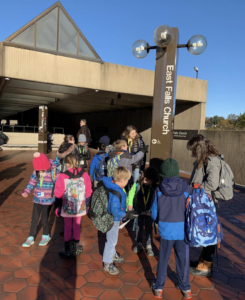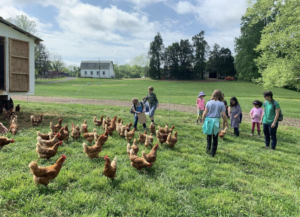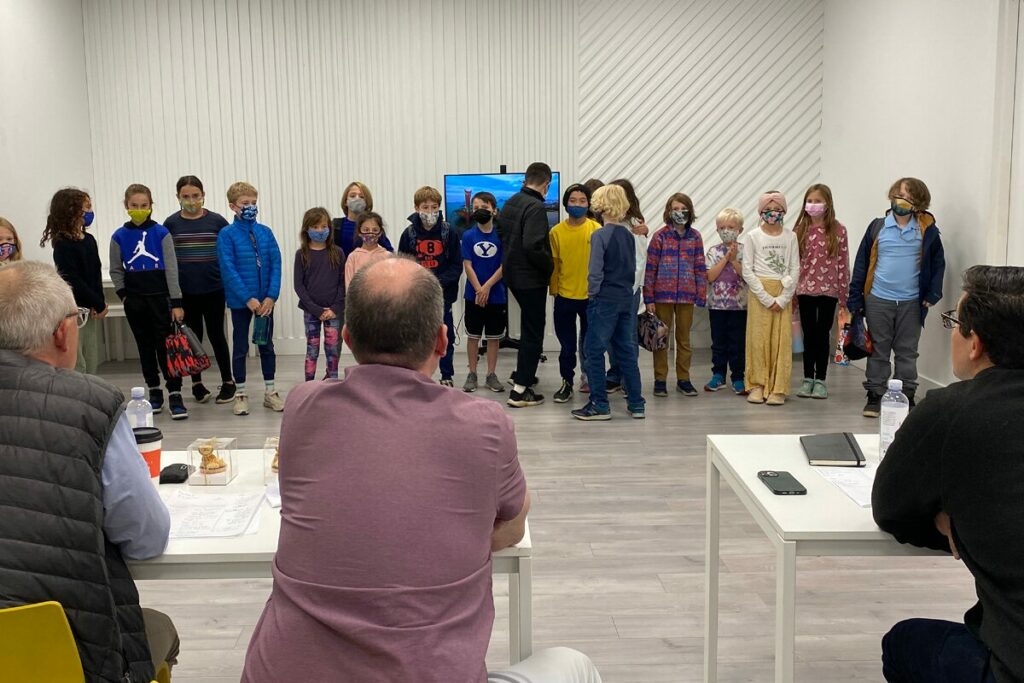I love growing this model and helping others see that there’s a totally different way of learning out there. Some of it is new and innovative but a lot of it is how we learned as early humans, in a village, not in a factory.
Lauren Quinn, Co-Founder and Director of The Village School
Recently, we had the opportunity to speak with Lauren Quinn, founder of The Village School in Arlington, VA. Their learning design is based on three pillars: Learner-Centered, Experience-Driven, and Character-Based. During our conversation, Lauren discusses The Village School’s approach to assessments, integration of open-walled learning, and what inspired her to start this learning environment.
Q: Can you tell me a little about The Village School and your learners?
Lauren: The Village School is a learner-driven micro-school in Northern Virginia. We are about to embark on our fifth year as a school. We started four years ago with 12 brave families and their learners with the idea that we wanted our kids to be able to have a more hands-on approach to learning. We’ve added about 15 learners each year and are embarking on year five with nearly 60 learners.
We want learners to follow their curiosities, and we really believe that who children are becoming and what they can do is a lot more important than what they know. This learner-driven model has its roots in the Montessori approach and philosophy, which is grounded in the fact that, as humans, we’re inherently curious and are all intrinsically motivated to learn. And, if given the right environment, we will learn and flourish. A big part of that is creating the right learning environment and then helping learners construct their own meaning from the experiences they create.
We’ll always be a micro-school. Part of our philosophy is that learning happens best in a close-knit, multi-age community of learners. When you think about how adults learn, we don’t learn from people just our own age, right? We learn from all kinds of people. The idea in the Village is that young people are exposed to lots of different people and mentors. They do apprenticeships — learning from the world, not just in a classroom with same-age peers.
Q: What is The Village School’s approach to assessment?
Lauren: The root of the word “assess” means “to sit beside,” and we’re very true to that. To truly know and understand what our learners are learning and to measure their progress, we have to sit beside them. Our guides — what we call “educators” — start with a portrait of a graduate. We think about who we want our children to become so we know exactly what we’re measuring and aiming for.
The portrait of a graduate follows in these four categories: Learning to Learn, Learning to Do, Learning to Be, and Learning to Live Together. Different things fall underneath those buckets. Learning to Learn covers foundational skills like reading and math, but that’s just one part of our model.
Learning to Do is really about what they can do with their learned knowledge and how they apply it. Can they set their own goals? Do they understand design thinking?
Learning to Be asks the questions: Who are you and who are you becoming? It is so critically important to whether a human flourishes in life. Our goal is human flourishing as a whole picture. Most importantly, we’re looking at curiosity. If the learners in our community are not curious, then we’re failing them in some way.
Learning to Live Together is exactly that — it’s not a solo journey. When we learn, we learn among others. We explore questions like: How are we connected to others? Can we collaborate? Can we communicate? Do we have a sense of servant leadership? That flows into environmental stewardship — which is a whole other part of our model. Our learners spend a good part of the day outside. If we want our children to make the world a better place, they have to spend time out in that world.
Q: What does open-walled learning look like in The Village School model?

Village School learners use the D.C. metro area and its world-class museums as part of their extended classroom. Navigating the metro is part of the learning experience.
Lauren: This is where the idea of a village really comes into play. We learn from being out in the world. We learn from trying things and experimenting, even if they don’t go well. We also learn from being around a lot of different kinds of people. In particular, we learn from people who are really passionate about what they’re doing. In learning to follow their curiosity, our goal is to give our learners agency so they can discover what they want to do and how they want to use their unique talents to contribute to the world and make it better.
On a less abstract level, we invite guests for “Hero Talks” where adults and mentors talk about what they do — ranging from artists to businesspeople. We’re out in the world often, but if we have people come in, they share about their life, about how they discovered what they’re passionate about, and a little bit about their job and their role. We are hoping to spark interest in our young people that they may not have previously known they had.
Sometimes we have those experts come in just to give feedback. If we’re doing an architecture quest, we’ll have an architect come in and give feedback, or we’ll go to their firm — it is always ideal to be in an authentic setting. Our middle schoolers have also apprenticeships. It gives them an opportunity to think about what they love, what they’re good at, and what they want to learn more about. They learn professional communication, how to interview, and how to land a job through these apprenticeships.
If you can think back to what it was like to be a kid or about what the most rewarding learning experiences have been as adults, I think we’d have a lot more empathy for children and what their school experience should look like.
[Kids] need freedom and responsibility if they’re really going to reach their full potential. And that can be really hard because it’s counter-cultural to how we’ve been raised.
Lauren Quinn, Co-Founder and Director of The Village School
Q: What are some of the biggest challenges The Village School faces?
Lauren: It’s always hard when you choose to do something that’s different from the status quo. From a very basic level, explaining to people what we’re doing and why we’re doing it without it seeming like we’re against anybody is a challenge. I was a public school educator, and there are so many wonderful educators doing amazing things. We want to communicate that we’re trying to create a viable model that hopefully others can learn from.
We’re a model that allows for failure but we as a society have become a culture that doesn’t leave a lot of room for failure. I think that can be really hard for parents to accept sometimes. As a larger society, I think we have forgotten what young people are capable of — and they’re capable of so much. Before the industrial era of education came in, kids were out doing real things, and they are eager for those opportunities now. They need freedom and responsibility if they’re really going to reach their full potential. And, that can be really hard because it’s counter-cultural to how we’ve been raised.
Finding educators or guides is also extremely difficult, believe it or not. It seems like many teachers dream about teaching in this kind of environment, but finding educators who are innovative and want to try something new has been a challenge. We tend to find outdoor educators because they understand the experiential part, but I think that there are a lot of amazing classroom and project-based teachers who would love to work in a school like ours, but communicating who we are and why it would be valuable for them is tricky. It’s a risk to do something new.
Q: What inspired you to get into this work? What was that journey like?
Lauren: During my junior year of high school, the administration called my parents and said that I wasn’t coming to school and would fail, needing to repeat my junior year. My mom asked how I was doing in my classes, and they told her I was getting all A’s and B’s and turning in my work, I just wasn’t showing up. Even as a young person, the concept of seat time didn’t work for me. I have always been a terrible rule follower and have been looking for a better way to help others learn because it wasn’t until college that I really fell in love with learning in a school setting.

Learners in Grades K-2 spend 2+ hours outside each day.
My college classes were smaller than my high school ones. They involved discussion. The instructor cared if you showed up. You were treated like an adult. I thought about that and really wanted something better for my kids. My kids were enrolled in kindergarten and second grade in our neighborhood public school, and I was working in Fairfax county at the time as an Advanced Academic Resource Teacher and Instructional Coach. My role in the county was really trying to help teachers use creative and critical thinking lessons, implement project-based learning and Socratic discussions — essentially all the things we know help children learn.
But, I felt like I was beating my head against the wall because, at the end of the day, what mattered in that system was what was on the standardized tests. Even the best teachers were being measured against how their students were doing on the test. I would be in a kindergarten class and see their creativity, hearing questions like, “How strong do you think ants are?” But I’d walk into a 6th-grade classroom and the children would be asking, “Will this be on the test?” It was really sad to me, and I saw a lot of disengagement.
That was concerning from a professional point of view but also as a mother. I started noticing similar things with both of my kids, who are very different from each other. My oldest started hating school. He would ask a lot of questions and told me that he was constantly told by the teacher to go in the corner and read because they were tired of his questions. I saw that light of curiosity begin to fade in his eyes. My younger son loved school and was rocking it. The reason was that he was a budding perfectionist who loved how easy it was to follow the rules and make his teachers happy. And to me, that was a whole different danger. We have kids like my older son who are labeled as “problem kids” for being curious and others like my youngest who might be a “dream student” but aren’t developing their interests and curiosity.
I looked at different models and found a network of learner-driven schools and various micro-schools. I connected with some of these entrepreneurial-minded individuals and given my background in education, took the leap to start The Village School. We started with just 12 learners and added more each year. I love growing this model and helping others see that there’s a totally different way of learning out there. Some of it is new and innovative but a lot of it is how we learned as early humans, in a village, not in a factory.

